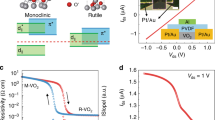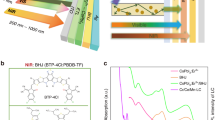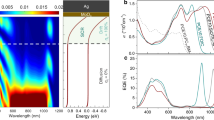Abstract
Ultraviolet photodetectors have applications in fields such as medicine, communications and defence1, and are typically made from single-crystalline silicon, silicon carbide or gallium nitride p–n junction photodiodes. However, such inorganic photodetectors are unsuitable for certain applications because of their high cost and low responsivity (<0.2 A W−1)2. Solution-processed photodetectors based on organic materials and/or nanomaterials could be significantly cheaper to manufacture, but their performance so far has been limited2,3,4,5,6,7. Here, we show that a solution-processed ultraviolet photodetector with a nanocomposite active layer composed of ZnO nanoparticles blended with semiconducting polymers can significantly outperform inorganic photodetectors. As a result of interfacial trap-controlled charge injection, the photodetector transitions from a photodiode with a rectifying Schottky contact in the dark, to a photoconductor with an ohmic contact under illumination, and therefore combines the low dark current of a photodiode and the high responsivity of a photoconductor (∼721–1,001 A W−1). Under a bias of <10 V, our device provides a detectivity of 3.4 × 1015 Jones at 360 nm at room temperature, which is two to three orders of magnitude higher than that of existing inorganic semiconductor ultraviolet photodetectors.
This is a preview of subscription content, access via your institution
Access options
Subscribe to this journal
Receive 12 print issues and online access
$259.00 per year
only $21.58 per issue
Buy this article
- Purchase on Springer Link
- Instant access to full article PDF
Prices may be subject to local taxes which are calculated during checkout





Similar content being viewed by others
References
Li, W. D. & Chou, S. Y. Solar-blind deep-UV band-pass filter (250–350 nm) consisting of a metal nano-grid fabricated by nanoimprint lithography. Opt. Express 18, 931–937 (2010).
Jin, Y. Z., Wang, J. P., Sun, B. Q., Blakesley, J. C. & Greenham, N. C. Solution-processed ultraviolet photodetedtors based on colloidal ZnO nanoparticles. Nano Lett. 8, 1649–1653 (2008).
Konstantatos, G. et al. Ultrasensitive solution-cast quantum dot photodetectors. Nature 442, 180–183 (2006).
Chen, H., Lo, M., Yang, G., Monbouquette, H. & Yang, Y. Nanoparticle-assisted high photoconductive gain in composites of polymer and fullerene. Nature Nanotech. 3, 543–547 (2008).
Sukhovatkin, V., Hinds, S., Brzozowski, L. & Sargent, E. H. Colloidal quantum-dot photodetectors exploiting multiexciton generation. Science 324, 1542–1544 (2009).
Konstantatos, G. & Sargent, E. H. Nanostructured materials for photon detection. Nature Nanotech. 5, 391–400 (2010).
Gong, X. et al. High-detectivity polymer photodetectors with spectral response from 300 nm to 1450 nm. Science 325, 1665–1667 (2009).
Arnold, M. S. et al. Broad spectral response using carbon nanotube/organic semiconductor/C60 photodetectors. Nano Lett. 9, 3354–3358 (2009).
Liu, J-M. Photonic Devices 960–986 (Cambridge Univ. Press, 2005).
Yoshikawa, H. & Adachi, S. Optical constants of ZnO. Jpn. J. Appl. Phys. 36, 6237–6243 (1997).
Redington, R. W. Maximum performance of high-resistivity photoconductors. J. Appl. Phys. 29, 189–193 (1958).
Chen, K. J., Hung, F. Y., Chang, S. J. & Young, S. J. Optoelectronic characteristics of UV photodetector based on ZnO nanowire thin films. J. Alloy Comp. 479, 674–677 (2009).
Li, Y., Della Valle, F., Simonnet, M., Yamada, I. & Delaunay, J-J. High-performance UV detector made of ultra-long ZnO bridging nanowires. Nanotechnology 20, 045501 (2009).
Kind, H., Yan, H. Q., Messer, B., Law, M. & Yang, P. D. Nanowire ultraviolet photodetectors and optical switches. Adv. Mater. 14, 158–160 (2002).
Soci, C. et al. ZnO nanowire UV photodetectors with high internal gain. Nano Lett. 7, 1003–1009 (2007).
Liang, S. et al. ZnO Schottky ultraviolet photodetectors. J. Cryst. Growth 225, 110–113 (2001).
Lao, C. S. et al. Giant enhancement in UV response of ZnO nanobelts by polymer surface-functionalization. J. Am. Chem. Soc. 129, 12096–12097 (2007).
Das, S. N. et al. ZnO single nanowire-based UV detectors. Appl. Phys. Lett. 97, 022103 (2010).
Basak, D., Amin, G., Mallik, B., Paul, G. K. & Sen, S. K. Photoconductive UV detectors on sol–gel-synthesized ZnO films. J. Cryst. Growth 256, 73–77 (2003).
Oosterhout, S. D. et al. The effect of three-dimensional morphology on the efficiency of hybrid polymer solar cells. Nature Mater. 8, 818–824 (2009).
Sun, B. Q., Marx, E. & Greenham, N. C. Photovoltaic devices using blends of branched CdSe nanoparticles and conjugated polymers. Nano Lett. 3, 961–963 (2003).
Huynh, W. U., Dittmer, J. J. & Alivisatos, A. P. Hybrid nanorod–polymer solar cells. Science 295, 2425–2427 (2002).
Verbakel, F., Meskers, S. C. J. & Janssen, R. A. J. Electronic memory effects in diodes from a zinc oxide nanoparticle–polystyrene hybrid material. Appl. Phys. Lett. 89, 102103 (2006).
Huang, Q. et al. Covalently bound hole-injecting nanostructures. Systematics of molecular architecture, thickness, saturation, and electron-blocking characteristics on organic light-emitting diode luminance, turn-on voltage, and quantum efficiency. J. Am. Chem. Soc. 127, 10227–10242 (2005).
Beek, W. J. E., Wienk, M. M., Kemerink, M., Yang, X. N. & Janssen, R. A. J. Hybrid zinc oxide conjugated polymer bulk heterojunction solar cells. J. Phys. Chem. B 109, 9505–9516 (2005).
Campoy-Quiles, M. et al. Morphology evolution via self-organization and lateral and vertical diffusion in polymer: fullerene solar cell blends. Nature Mater. 7, 158–164 (2008).
Baoquan, S., Snaith, H. J., Dhoot, A. S., Westenhoff, S. & Greenham, N. C. Vertically segregated hybrid blends for photovoltaic devices with improved efficiency. J. Appl. Phys. 97, 014914 (2005).
Acknowledgements
This work was supported by the Office of Naval Research (ONR, grant no. N000141210556), a Defense Threat Reduction Agency (DTRA) Young Investigator Award (HDTRA1-10-1-0098) and the University of Nebraska–Lincoln.
Author information
Authors and Affiliations
Contributions
J.H. conceived the idea. J.H. and F.G. designed the experiments and analysed the data. F.G. carried out the fabrication of devices, measurements and data analysis. Y.B., B.Y. and Q.D. synthesized ZnO nanoparticles. B.Y. and Z.X. fabricated the single carrier devices. J.H. and F.G. wrote the manuscript.
Corresponding author
Ethics declarations
Competing interests
The authors declare no competing financial interests.
Supplementary information
Rights and permissions
About this article
Cite this article
Guo, F., Yang, B., Yuan, Y. et al. A nanocomposite ultraviolet photodetector based on interfacial trap-controlled charge injection. Nature Nanotech 7, 798–802 (2012). https://doi.org/10.1038/nnano.2012.187
Received:
Accepted:
Published:
Issue Date:
DOI: https://doi.org/10.1038/nnano.2012.187
This article is cited by
-
Differential perovskite hemispherical photodetector for intelligent imaging and location tracking
Nature Communications (2024)
-
Silver telluride colloidal quantum dot infrared photodetectors and image sensors
Nature Photonics (2024)
-
Free-standing 2D gallium nitride for electronic, excitonic, spintronic, piezoelectric, thermoplastic, and 6G wireless communication applications
NPG Asia Materials (2023)
-
Low-dimensional wide-bandgap semiconductors for UV photodetectors
Nature Reviews Materials (2023)
-
Ultrasensitive solar-blind ultraviolet detection and optoelectronic neuromorphic computing using α-In2Se3 phototransistors
Frontiers of Physics (2023)



